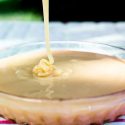What are Potassium Phosphates (E340) in food, Uses and Differences?

Production | Safety | Types
Potassium phosphate refers to various inorganic salts of potassium (K+) and phosphate (PO43−). It includes monopotassium phosphate, dipotassium phosphate and tripotassium phosphate.
They’re the multifunctional food additives that can be used as a buffering agent, sequestrant, emulsifier, nutrient supplement, low-sodium replacement in food with the European food additive number E340. Meanwhile, as the water-soluble fertilizers.
The category of potassium phosphate may also contain tetrapotassium pyrophosphate, potassium tripolyphosphate and potassium polyphosphate.
Production
Phosphates are obtained from naturally occurring phosphate rock. Potassium phosphate is commercially derived from the neutralization of phosphoric acid with potassium hydroxide or potassium carbonate.
Safety
When used as food additives, they almost have no side effects and safety has been approved by the U.S. Food and Drug Administration (FDA) and European Food Safety Authority (EFSA), as well as the Joint FAO/WHO Expert Committee on Food Additives (JECFA).
Types of Potassium phosphates
Food grade potassium phosphates including four types: potassium orthophosphates, tetrapotassium pyrophosphate, potassium tripolyphosphate and potassium polyphosphate.
Mono-, di- and tripotassium phosphates
They’re made of ions of potassium (K+) and dihydrogen phosphate (H2PO4−), hydrogen phosphate (HPO42−), and orthophosphate (PO43−), respectively.
Monopotassium phosphate
MKP or KDP, chemical formula KH2PO4, also known as potassium dihydrogen phosphate or potassium phosphate monobasic.
It is an acid and can be used as an acidity regulator, leavening acid, sequestrant and potassium supplement in food with the European food additive number E340(i).
Sports drink and coffee creamers are its common applications. However, this ingredient is used much as a fertilizer than in food.
Learn more about Monopotassium phosphate
Dipotassium phosphate
DKP, chemical formula K2HPO4, also known as potassium phosphate dibasic or dipotassium hydrogen phosphate.
It is a weak acid that can be used as an electrolyte in beverage and bodybuilding food, and as a buffering agent to adjust PH in non-dairy creamer, milk products, cheese and meat. The European food additive number for it is E340(ii).
It is also a water-soluble phosphorus and potassium-based fertilizer.
In pharmaceutical uses, a concentrated solution composed of mono- and dibasic potassium phosphate in water can be used as an electrolyte replenisher to treat or prevent hypophosphatemia (low blood levels of potassium). (1)
Learn more about Dipotassium phosphate
Tripotassium phosphate
TKP, chemical formula K3PO4, also known as potassium phosphate tribasic with the European food additive number E340(iii).
The food grade is primarily used as an acidity regulator and to increase PH in cereal. It can also be used to replace trisodium phosphate.
It exists in three forms and follows the chemical formula:
- Anhydrous: K3PO4
- Monohydrate: K3PO4.H2O
- Trihydrate: K3PO4.3H2O
Learn more about Tripotassium phosphate
Tetrapotassium pyrophosphate
TKPP, chemical formula K4P2O7, also known as tetrapotassium diphosphate or potassium pyrophosphate, with the European food additive number E450(v).
It is made from the reaction of phosphoric acid with potassium hydroxide, crystallized, and follows heating under 350-400℃. Below are the chemical equations:
- 2KOH+H3PO4 → K2HPO4+H2O
- K2HPO4·6H2O→ K2HPO4·3H2O
- K2HPO4·3H2O → K2HPO4
- K2HPO4 → K4P2O7
Potassium pyrophosphate is widely used in the washing, leather, and electroplating industries.
Its food grade has the effect of inhibiting food spoilage due to its strong alkaline. It can be used as an emulsifier and texture improver in soup, frozen fish & shrimp, cooked pork, minced meat, and etc. It also functions as a PH regulator and stabilizer.
Potassium polyphosphate
Chemical formula (KPO3)n, also known as potassium metaphosphate or potassium polymetaphosphate, the European food additive number E452(ii).
It is a highly polymerized linear polyphosphate, and may contain a small amount of cyclic structured potassium trimetaphosphate and potassium tetrametaphosphate.
It is polymerized from potassium dihydrogen phosphate in high temperature.
Potassium tripolyphosphate
KTPP, chemical formula K5O10P3, also known as pentapotassium tripolyphosphate or potassium triphosphate, the European food additive number E451(ii).
It can be obtained by the reaction of monopotassium phosphate and dipotassium phosphate through various manufacturing processes. The brief chemical equations as follows:
- 5K2C03+6H3PO4 =4K2HPO4+2KH2PO4+5CO2+5H2O
- 4K2HPO4+2KH2PO4=2K2PO7+K2H2P2O7+3H2O
- 4K2HPO4+K2H2P2O=K2P3O10+3H2O
Or produced by potassium carbonate neutralization reaction with peroxophosphoric acid as follows:
4H5P3O10+10K2CO3=4K5P3O10+10CO2+10H2O
Potassium tripolyphosphate used in food due to its excellent dispersion, emulsification, water holding capacity, buffering effect and chelating ability on metal ions (Ca2+ and Mg2+ ).
Conclusion
Now you may have a knowledge of the food additive – Potassium phosphates (E340), from three types, production, uses, and approved safety.
Also tetrapotassium pyrophosphate, potassium tripolyphosphate and potassium polyphosphate.
What do you think of these ingredients? Let me know in the comments.



additive code for dibasic sodium phosphate dehydrate…